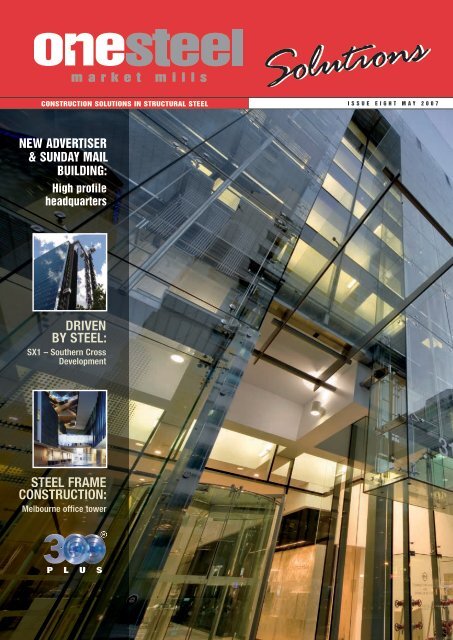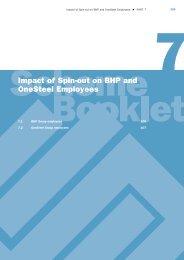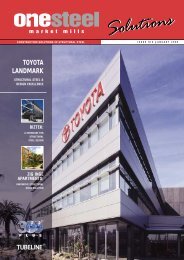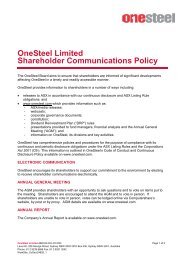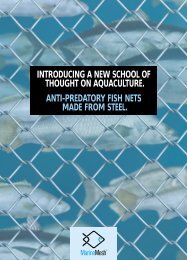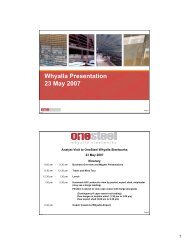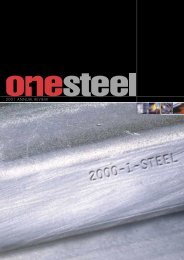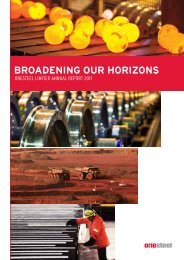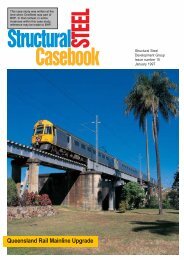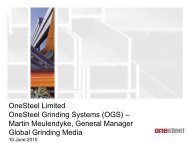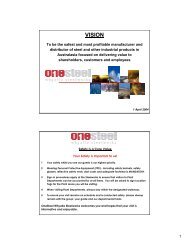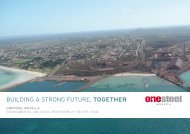STEEL FRAME CONSTRUCTION: DRIVEN BY STEEL: - OneSteel
STEEL FRAME CONSTRUCTION: DRIVEN BY STEEL: - OneSteel
STEEL FRAME CONSTRUCTION: DRIVEN BY STEEL: - OneSteel
Create successful ePaper yourself
Turn your PDF publications into a flip-book with our unique Google optimized e-Paper software.
Construction Solutions in Structural Steel<br />
I S S U E E I G H T M A Y 2 0 0 7<br />
NEW ADVERTISER<br />
& SUNDAY MAIL<br />
BUILDING:<br />
High profile<br />
headquarters<br />
<strong>DRIVEN</strong><br />
<strong>BY</strong> <strong>STEEL</strong>:<br />
SX1 – Southern Cross<br />
Development<br />
<strong>STEEL</strong> <strong>FRAME</strong><br />
<strong>CONSTRUCTION</strong>:<br />
Melbourne office tower
c o n t e n t s<br />
solutions<br />
WELCOME TO<br />
ONE<strong>STEEL</strong> SOLUTIONS.<br />
In the last issue of <strong>OneSteel</strong> Solutions we highlighted the increase<br />
in market share of steel-framed buildings in the multistorey<br />
buildings market. At the time of publishing, many of those<br />
buildings that contributed to the increasing share count were<br />
still in the construction stage. In this issue of <strong>OneSteel</strong> solutions<br />
we take a closer look at some of these buildings which are now<br />
complete, including several of the more high-profile buildings that<br />
are being added to the Australian skyline.<br />
Two high-rise buildings, namely the Southern Cross Building and<br />
the Urban Workshop from Melbourne, are featured in the pages to<br />
follow. The medium-rise buildings, specifically Latitude East, The<br />
Advertiser and Sunday Mail Building, and Flinders Link, illustrate<br />
that steel framing is suitable for a range of heights, occupancies<br />
and styles of buildings.<br />
When the projects were being researched for this publication,<br />
it was noticeable that the design teams all mentioned the<br />
sustainability aspects of their particular project. <strong>OneSteel</strong>,<br />
and indeed the steel industry, has over a number of years now,<br />
looked at the role that steel can play in sustainable developments.<br />
In this edition of <strong>OneSteel</strong> Solutions we take a look at this issue<br />
and will continue to explore the possibilities in more detail in the<br />
near future.<br />
Please enjoy this issue of <strong>OneSteel</strong> Solutions.<br />
3 IN THE NEWS<br />
• COMPOSITE ANALYSIS<br />
SOFTWARE<br />
Release of Latest Suite<br />
• ConnectED 2007<br />
<strong>OneSteel</strong> – proud sponsors of<br />
UNSW ConnectED<br />
• MARKET ASSISTANCE<br />
• <strong>OneSteel</strong> COMMUNIQUÉ<br />
NEWSLETTER<br />
Launch of monthly e-newsletter<br />
4 Structural Steel’s role<br />
In Sustainable Developments<br />
5 CASE STUDY:<br />
THE NEW ADVERTISER &<br />
SUNDAY MAIL BUILDING<br />
The new high-profile<br />
headquarters for Adelaide<br />
9 CASE STUDY:<br />
LATITUDE EAST @<br />
WORLD SQUARE<br />
Experience & steel industry knowhow<br />
deliver a win-win result<br />
13 CASE STUDY:<br />
<strong>STEEL</strong> <strong>FRAME</strong> <strong>CONSTRUCTION</strong><br />
DELIVERS<br />
New standards for Melbourne<br />
office tower<br />
17 CASE STUDY:<br />
<strong>DRIVEN</strong> <strong>BY</strong> <strong>STEEL</strong><br />
SX1 – Southern Cross<br />
development<br />
21 CASE STUDY:<br />
BIG DEVELOPERS COMBINE<br />
IN <strong>STEEL</strong> TO CONNECT<br />
FLINDERS LINK<br />
Three developers combine to<br />
create Flinders Link in Adelaide<br />
24 CONTACTS<br />
<strong>OneSteel</strong> Solutions<br />
issue 8 page
in the news<br />
Composite<br />
Analysis<br />
Software<br />
<strong>OneSteel</strong> has recently completed<br />
the latest upgrade to its suite of<br />
Composite Analysis Software. The<br />
new suite consists of:<br />
CompSelector ® V1.0;<br />
CompLoader ® V1.0;<br />
COMPBEAM ® V2.1;<br />
CompPanel ® V1.2 (upgraded) and<br />
CompPen ® V1.0 (New)<br />
Version 1.2 of CompPanel ® now has a<br />
‘save’ function following feedback from<br />
designers that they would like to have<br />
the files stored electronically as well<br />
as on paper. CompPen ® , which allows<br />
web penetrations in composite beams<br />
to be analysed, is a new edition to the<br />
suite. CompPen ® will enable designers<br />
to either check a web penetration<br />
for structural adequacy or allow the<br />
software to determine the largest<br />
penetration allowable in a given position<br />
along the composite beam.<br />
Development is currently underway to<br />
write a module that will assist in the<br />
design of shear reinforcement.<br />
To get the latest copy of the software, fill<br />
out and return the coupon attached to<br />
this issue of <strong>OneSteel</strong> Solutions or call<br />
<strong>OneSteel</strong> Direct on 1800 1 <strong>STEEL</strong>.<br />
ConnectED 2007<br />
<strong>OneSteel</strong> is a proud sponsor of the University of New South Wales<br />
(UNSW) ConnectED Structure.<br />
This structure will be the combined creation of students from three Faculties of UNSW – The College of<br />
Fine Arts, Engineering and Built Environment. The structure will be the icon for the ConnectED Conference<br />
and have a prominent position on the Kensington campus through the duration of the conference.<br />
Creative and innovative design has a key role to play in the quest for designing environmentally<br />
sustainable buildings. <strong>OneSteel</strong> sees as one of its corporate responsibilities to promote sustainable<br />
developments to the designers of the future. As a material sponsor of the ConnectED Structure,<br />
<strong>OneSteel</strong> were given the opportunity to present to the students of the three faculties. <strong>OneSteel</strong> took<br />
this opportunity to promote ideas on design for sustainability. Students were encouraged to explore<br />
the possibilities of designs using steel sections which are deconstructed from other structures. The<br />
students were also challenged to consider designing a structure that could be easily deconstructed and<br />
relocated, or so that the steel could be recycled without the need for remelting.<br />
The students’ submissions can be viewed on the ConnectED website:<br />
http://au.omnium.net.au/projectx/mod/galleries/gallery.phpgix_id=18<br />
Market Assistance<br />
<strong>OneSteel</strong> has, since its origin, provided<br />
technical and market support to<br />
designers, builders and developers.<br />
This support includes the provision<br />
of design tools and publications,<br />
design advice for construction and<br />
fire engineering, a complementary<br />
composite steel design service, advice<br />
on products and facilitating expert<br />
advice. David Bell looks after the<br />
North/East Region covering NSW, ACT<br />
and QLD, while Spiros Dallas looks<br />
after the South/West Region covering<br />
VIC, TAS, SA, WA and NT.<br />
Both David and Spiros welcome any<br />
enquiries you may have on your next<br />
building project. It is their strong belief<br />
that the earlier they are involved in a<br />
project the better they are able to assist.<br />
Their contact details are listed below.<br />
David Bell – (02) 9792 9075<br />
0407 357 120<br />
Spiros Dallas – (03) 8312 2633<br />
0419 587 951<br />
Gary Oldfield, who has performed<br />
this role in Victoria for 36 years, has<br />
retired from <strong>OneSteel</strong>. While Gary was<br />
at <strong>OneSteel</strong> he was also very active in<br />
serving on numerous industry bodies<br />
including Engineers Australia and ASI.<br />
Nick van der Kreek, who previously<br />
serviced the Queensland market, has<br />
taken the role as <strong>OneSteel</strong>’ Technical<br />
Development Manager.<br />
<strong>OneSteel</strong> Communiqué Newsletter<br />
<strong>OneSteel</strong> has just launched a new email newsletter. <strong>OneSteel</strong> Communiqué is designed to provide practical know-how,<br />
showcase architectural and construction case studies and deliver the most up-to-the-minute news on steel initiatives.<br />
<strong>OneSteel</strong> Communiqué is a not-to-be-missed monthly e-newsletter. If you’re not already on the distribution list, you can<br />
make sure you are for future editions by calling or emailing <strong>OneSteel</strong> Direct 1800 1 <strong>STEEL</strong> or onesteeldirect@onesteel.com<br />
To see a copy of the first issue of <strong>OneSteel</strong> Communiqué, log onto www.onesteel.com<br />
<strong>OneSteel</strong> Solutions<br />
issue 8 page
Structural Steel’s Role in<br />
SUSTAINABLE DEVELOPMENTS<br />
Grandstand at WIN Stadium<br />
relocated from the Aquatic Centre.<br />
It is generally accepted that the definition of Sustainable<br />
Development (SD) is: “Development that meets the<br />
needs of the present without compromising the ability<br />
of future generations to meet their own needs”<br />
The underlying principle behind this<br />
definition of SD is that there needs to be<br />
an integration of economic, environmental<br />
and social considerations, whilst seeking<br />
the optimal outcomes. These key factors<br />
should not be examined in isolation but<br />
in totality and a long-term view rather than<br />
a short-term view should be taken<br />
in making decisions.<br />
Even though the tools for making better<br />
SD decisions is a developing area, there<br />
is a strong and growing drive by the<br />
community to readily adopt all that is<br />
believed to be SD, and not necessarily with<br />
much understanding of whether tools or<br />
decisions are scientifically well grounded.<br />
The increased level of embracement of SD<br />
principles and tools is particularly driven by<br />
the broader community’s realisation that<br />
human interaction with the environment<br />
is impacting on climate change and water<br />
resources. Currently the most popular tools<br />
used to measure or compare the level of<br />
sustainability between developments are in<br />
the form of a checklist or scorecard. As a<br />
developing science, it is important that these<br />
tools are simple and easily adjustable to<br />
cater for the ever-increasing improvements<br />
in the science that will affect arbitrary<br />
weighting factors, credit points, and<br />
aspects to be rated in those tools. They<br />
Better informed<br />
design is the key.<br />
should be relevant in the decision making<br />
for building design and operation for the<br />
entire life cycle of the building including<br />
design, materials production, construction,<br />
operation, maintenance, demolition,<br />
component reuse or material recycle.<br />
If we look back at the definition of SD, we<br />
realise that the integration of environmental,<br />
economic and social policies is a complex<br />
task which is difficult to package and<br />
calibrate using just a simple scorecard.<br />
To be effective it requires all the<br />
stakeholders to examine the consequences<br />
of the scorecard and offer research and<br />
opinions to improve the calibration of these<br />
scorecards. <strong>OneSteel</strong> is committed to the<br />
environment and therefore has allocated<br />
resources into this area to provide feedback<br />
to the organisations responsible for<br />
administering these scorecards.<br />
The Green Buildings Council Australia’s<br />
Green Star system is one such a rating<br />
tool for which <strong>OneSteel</strong> has provided<br />
submissions to identify areas or issues.<br />
Steel is the most recycled material in the<br />
world by weight. This is presumably the<br />
reason why it is one of the first things<br />
that comes to mind when considering<br />
SD. However, this is not the key, better<br />
informed design is the key. In its<br />
submissions <strong>OneSteel</strong> has also reflected<br />
on the hierarchy of factors that will<br />
improve the environmental performance<br />
of buildings which contain structural steel.<br />
The hierarchy is based on the simple fact<br />
that the order of importance in SD is (1)<br />
Reduce; (2) Reuse; and finally (3) Recycle.<br />
<strong>OneSteel</strong> and its predecessors have devoted<br />
significant resources to improving the<br />
material strengths of their steel products.<br />
While this was predominantly to be the able<br />
to offer a premium product in the market<br />
place, from an SD perspective, it has also<br />
effectively reduced the amount of steel that<br />
would otherwise be consumed. The support<br />
<strong>OneSteel</strong> has offered to the development<br />
of Australian Design Standards and the<br />
design guides that <strong>OneSteel</strong> publishes<br />
promoting more economical designs are<br />
also now effectively facilitating design of<br />
SD by reducing the amount of steel that<br />
would have been used.<br />
Steel-framed buildings are chosen by<br />
many developers because of the inherent<br />
ease with which they can be modified<br />
or adapted. These buildings are easily<br />
extended either vertically or laterally,<br />
unbolted and re-bolted, strengthened and<br />
reshaped because of the nature of the<br />
connection of one piece of steel to another.<br />
Furthermore good design at inception will<br />
allow the steel elements of the structure<br />
to be unbolted and reused elsewhere.<br />
The grandstand seating for the Olympics<br />
at the Sydney Aquatic Centre, which has<br />
been disassembled and relocated to WIN<br />
Stadium, is one such high-profile example.<br />
Refurbishing steel members by re-rolling<br />
to straighten, cutting and drilling, etc<br />
for new application is also an option to<br />
consider before recycling. Component<br />
reuse will save more energy and reduce<br />
greenhouse effects, compared to the<br />
next option of remelting into new steel.<br />
However, when all the reduce and reuse<br />
options are exhausted the steel can be<br />
recycled as is already the case with<br />
around 95% of structural steel that is<br />
used for construction in Australia.<br />
The Green Buildings Council Australia<br />
has recently launched a Shopping Centre<br />
Design Pilot, which includes a new section<br />
in the Materials category that allocates<br />
points to “Reused Products and Materials”<br />
and “Disassembly and Adaptability”.<br />
This is a very pleasing development<br />
and indicates that the submissions by<br />
<strong>OneSteel</strong> and others are now being<br />
considered.<br />
For more information on<br />
sustainable developments<br />
contact <strong>OneSteel</strong> direct on<br />
1800 1 78335 (1800 1 <strong>STEEL</strong>)<br />
<strong>OneSteel</strong> Solutions<br />
issue 8 page
300PLUS ®<br />
Ernst & Young Centre<br />
The new Advertiser<br />
& Sunday Mail Building<br />
The new high-profile headquarters of the<br />
Advertiser and Sunday Mail newspapers follows<br />
an Adelaide trend to build in steel. The project,<br />
which won Best Commercial Building at last<br />
year’s RAIA (South Australian Chapter) Awards<br />
was built with 1200 tonnes of structural steel at<br />
a cost of $50 million.<br />
The five-storey building, at 31<br />
Waymouth Street, is a steel-framed<br />
office construction using composite steel<br />
beams with a basement level and twostorey<br />
plant mezzanine above the roof.<br />
The building fits comfortably into the<br />
podium scale of the street and has<br />
been designed to enhance the quality<br />
of the pedestrian environment and<br />
provide a visually exciting façade on<br />
Waymouth Street.<br />
Designed by E.G.O │Fender Katsalidis,<br />
a joint venture between E.G.O, the<br />
Sydney commercial interior design firm<br />
and architects Fender Katsalidis, the<br />
impressive architecture presents a glass<br />
façade wall, while inside the building<br />
an atrium runs north to south, linked by<br />
bridges at each level from the lifts to the<br />
working floors. An open stairwell runs up<br />
through the atrium creating an ambience<br />
of light and space.<br />
The atrium, which runs the full height<br />
of the building, is a soaring space,<br />
naturally lit from above. This space<br />
allows immediate understanding of<br />
the workings of the building whilst<br />
providing natural light to the deep plan<br />
office floors. It also provides incidental<br />
staff meeting places via bridges which<br />
connect each office floor to the lift core<br />
and toilets, creating an environment for<br />
social and information exchange.<br />
Full height atrium<br />
naturally lit from above.<br />
<strong>OneSteel</strong> Solutions<br />
issue 8 page
300PLUS ®<br />
Advertiser & Sunday Mail Building<br />
The building was on a tight design and<br />
construction schedule with financial<br />
penalties for the client if not occupied<br />
on time. Because of the medium-rise<br />
character of the building, structural<br />
engineers, Peter McBean and Loreto<br />
Taglienti of Wallbridge & Gilbert, in<br />
consultation with the architects, took<br />
the decision to use steel as the primary<br />
framing material to enable fast erection<br />
of the primary elements of the building.<br />
That approach meant that the fire-rating<br />
of the structure was taken off the critical<br />
path. Steel also provided the flexibly<br />
for the architecture, allowing for large<br />
edge cantilevers – an important part in<br />
realising the lightness of structure at the<br />
façade. While some of the steelwork was<br />
repetitive, other sections were unique.<br />
The typical 8.1 metre X 8.1 metre<br />
grid comprises <strong>OneSteel</strong> 300PLUS ®<br />
460UB67 primary and 410UB54<br />
secondary beams acting compositely<br />
with the steel-profile decking. Because<br />
of the large floor plate size the floorto-ceiling<br />
heights of 3 metres are<br />
significantly higher than is typical<br />
for office buildings. This avoids the<br />
horizontal squeezing of the internal view<br />
cone that would otherwise occur.<br />
The north and south perimeters have<br />
been designed to be column free. The<br />
3.5-metre cantilevered floors to the<br />
south and in particular to the north also<br />
influenced the selection of structural<br />
steel framing.<br />
On level two (the editorial floor) the<br />
client required a larger floor plate so the<br />
southern building edge at this level was<br />
designed to cantilever 3.6 metres out<br />
from the building face. This solution was<br />
made possible by large steel cantilever<br />
beams, which in turn become part of the<br />
visual expression of the building.<br />
The north façade in particular required<br />
an elegant and minimalist structural<br />
solution which could only be achieved<br />
through the use of steel. Deflection<br />
control of the cantilevered floors was<br />
very tight in order to service the façade<br />
weather seal. Consequently, Wallbridge &<br />
Gilbert considered steel the appropriate<br />
solution because of the greater<br />
deflection predictability, compared<br />
to a concrete structure.<br />
echoing the nature of the work within<br />
and communicating graphically the<br />
power of the use of words. It also<br />
provides pedestrian shelter along<br />
Waymouth Street and strategically<br />
locates the main public and corporate<br />
entrances to the building though a series<br />
of transition spaces from the public<br />
domain of the street and footpath into a<br />
lobby, before passing the security point<br />
into the building proper.<br />
The choice of hollow section columns<br />
was innovative as they provided an<br />
efficient, cost-effective and time-saving<br />
solution. Concrete-filled 400 x 400 x<br />
10.0 Square Hollow Sections (SHS)<br />
were used around the perimeter of the<br />
building, saving up to 30% in steel mass<br />
and fabrication costs.<br />
Floor beam connections to the hollow<br />
section columns took several forms.<br />
Circular Hollow Sections (CHS) columns<br />
with simply supported beams were<br />
connected by a single line of bolts to a<br />
web side plate welded to the column<br />
face. Continuous cantilevered beams<br />
utilised stub beams welded to the<br />
column face with (top and bottom)<br />
flanges welded to ring stiffeners around<br />
the column perimeter. Bolted moment<br />
end plate connections joined the stub<br />
beam to the suspended cross beams.<br />
The north façade in particular<br />
required an elegant and minimalist<br />
structural solution which could only<br />
be achieved through the use of steel.<br />
The glass façade on Waymouth Street.<br />
The glass façade has an inner skin<br />
curtain wall with an extended glass wall<br />
another metre away. This innovative<br />
‘second glass skin’ across the<br />
Waymouth Street frontage enlivens the<br />
building and integrates the corporate<br />
identity within an elegant, well<br />
considered façade.<br />
Environmentally it provides acoustic<br />
and thermal protection and shading as<br />
well as creating a distinctive urbane<br />
and graphically communicative façade,<br />
Perimeter SHS columns were either<br />
continuous with web side plate<br />
connected beams or, when these beams<br />
were cantilevered beyond the column<br />
line, discontinuous at every floor with<br />
cap and base plates connected to<br />
continuous beams. The floors were tied<br />
back to the two service cores, laterally<br />
bracing the building.<br />
Technology was critical to executing the<br />
multifaceted design. The integration of<br />
the 3D software enabled the exchange<br />
<strong>OneSteel</strong> Solutions<br />
issue 8 page
CLIENT<br />
Advertiser Newspapers Pty<br />
Limited<br />
ARCHITECT<br />
E.G.O Fender Katsalidis<br />
PROJECT MANAGER<br />
E.G.O Group<br />
STRUCTURAL ENGINEER<br />
Wallbridge & Gilbert<br />
BUILDING CONTRACTOR<br />
Baulderstone Hornibrook<br />
<strong>STEEL</strong>WORK CONTRACTOR<br />
Manuele Engineers<br />
This award-winning, high-profile<br />
office building is a demonstration<br />
of steel’s design flexibility.<br />
<strong>STEEL</strong> DETAILER<br />
USDSA<br />
<strong>STEEL</strong> DISTRIBUTOR<br />
<strong>OneSteel</strong> Steel and Tube;<br />
Smorgon Steel Metals<br />
Distribution<br />
<strong>OneSteel</strong> Solutions<br />
issue 8 page
300PLUS ®<br />
Advertiser & Sunday Mail Building<br />
Innovative glass façade with<br />
an inner skin curtain wall.<br />
of shop drawings between the architect,<br />
engineer and detailer. Steel detailer<br />
USDSA created a 3D model as part of<br />
the USDSA/Manuele Engineers Joint<br />
Venture (drafting and manufacture inhouse)<br />
which allowed the steelwork to<br />
be both drawn and fabricated quickly<br />
offsite to meet the tight construction<br />
timeframes. Steelwork also meant<br />
a less congested site with a smaller<br />
construction team and reduced risk.<br />
This award-winning, high-profile<br />
building, with approximately 15,500<br />
square metres of office space over five<br />
storeys, is a demonstration of steel’s<br />
design flexibility, cost and time benefits<br />
and offers an example of what steel can<br />
deliver for multi-level developments. The<br />
steel frame of the Advertiser building will<br />
mean that changes for future use can<br />
more easily be accommodated.<br />
Fire engineering<br />
Advances in fire engineering design<br />
were key to the final framing system’s<br />
economy and competitiveness.<br />
Sprinklers and concrete-filled hollow<br />
section columns provide significant<br />
efficiencies to enable concessions on fire<br />
ratings to make the final framing system<br />
economically competitive.<br />
The fire engineering study allowed the<br />
majority of beams to be bare steel and<br />
the critical members to have a reduced<br />
fire resistance level (FRL). The 120<br />
minutes FRL required by the Building<br />
Code of Australia (BCA) deemed to<br />
satisfy requirements was reduced to<br />
60 minutes. This meant that only one<br />
coat of intumescent paint was needed to<br />
provide the required protection.<br />
Fire engineering design was done to<br />
Australian Standards and British guidelines.<br />
The gross floor area at each level is<br />
approximately 3100 square metres.<br />
An environmentally<br />
sustainable building<br />
Designed in an environmentally<br />
responsible manner the building limits<br />
emissions and other environmental<br />
pollutants. Careful consideration has<br />
been given to energy conservation,<br />
materials and user health and comfort,<br />
private and public realm and transport.<br />
The building design is consistent with<br />
Council Wide Principles 25 and 26.<br />
The Waymouth Street north façade<br />
has significant protection against solar<br />
infiltration into the interior. Horizontal<br />
sun-shading devices, located at each<br />
floor level and at intermediate levels,<br />
provide shading before the sun reaches<br />
the glazing proper. Sun shades are<br />
encapsulated within a ventilated doubleglass<br />
façade. The outer skin of glass<br />
provides an initial means of converting<br />
the solar radiation into heat before<br />
reaching the main building façade. The<br />
fine dot graphics, incorporated into the<br />
façade, provide additional shading.<br />
The western façade of the building<br />
is masonry, built against an existing<br />
building, and therefore not subject to<br />
heat infiltration.<br />
A much higher building (part of a<br />
redevelopment proposed to the east)<br />
is to be constructed, shading the east<br />
façade of the site further. Because of<br />
this factor and its orientation, the solar<br />
load on this façade is not great and<br />
is dealt with through the choice of an<br />
appropriately performing glazing system<br />
and integrated solar screenings.<br />
Stormwater runoff is collected and<br />
recycled in the watering systems for<br />
the courtyard and roof terrace and for<br />
flushing systems within the building.<br />
The building fabric is designed to reduce<br />
the heating and cooling loads on the air<br />
conditioning which has design initiatives<br />
that minimise energy consumption over<br />
traditional air conditioning systems.<br />
Walls and the roof materials have been<br />
selected from high thermal performance<br />
materials to substantially reduce heat<br />
transmission into space (and heat loss<br />
from the space in winter).<br />
More efficient lighting will reduce lighting<br />
energy consumption by more than<br />
50% based on typical office occupied<br />
hours. Wiring to the lighting has been<br />
configured to incorporate intelligent<br />
lighting controls that automatically<br />
switch off lights when an area is<br />
unoccupied. Similar wiring based on<br />
daylight controls lights close to the<br />
perimeter of the building.<br />
The carpark ventilation includes<br />
CO 2 monitoring to minimise energy<br />
consumption from the carpark exhaust<br />
and ventilation fans.<br />
Steel – The competitive advantage<br />
• On-time occupation for the client.<br />
• Steel facilitated greater flexibility in the architectural expression allowing large edge cantilevers,<br />
to realise the desired lightness at the façade.<br />
• A steel frame enabled fast erection of the primary elements of the building for speedy enclosure.<br />
• The steel solution gave greater deflection predictability and control of the cantilevered floors.<br />
• Advances in fire engineering design were key to the final framing system’s economy<br />
and competitiveness.<br />
• The integration of the 3D software enabled the exchange of shop drawings between the architect,<br />
engineer and detailer.<br />
• Offsite fabrication of the steelwork provided a less congested site with a smaller construction team<br />
and reduced risk.<br />
<strong>OneSteel</strong> Solutions<br />
issue 8 page
Latitude East @<br />
World Square<br />
E x p e r i e n c e a n d s t e e l i n d u s t r y<br />
k n o w - h o w d e l i v e r a w i n - w i n r e s u lt<br />
The last construction on the World Square site is a<br />
ten-storey A-Grade commercial office building known<br />
as Latitude East. The new building sits on top of<br />
an existing 12-storey concrete structure. The glass<br />
façade structure with an enclosed atrium is being<br />
built above the World Square Retail Complex.<br />
When completed in November 2007 it will deliver<br />
around 25,000 square metres of floor space, to<br />
be occupied by the Australian Taxation Office.<br />
An oversized pressed metal edge form was used at<br />
the edges of the slabs, enabling pouring to a level.<br />
<strong>OneSteel</strong> Solutions<br />
issue 8 page
300PLUS ®<br />
Latitude East @ World Square<br />
Designed by leading architects Crone<br />
Partners and engineered by Taylor<br />
Thomson Whitting (TTW) Latitude East<br />
is being developed on the World Square<br />
site by Multiplex and follows the three<br />
high-rise towers and the Retail Complex<br />
completed between September 2002<br />
and May 2006. Construction on this<br />
site has presented a number of design<br />
challenges, not the least of which has<br />
been the pre-existence of the multi-level<br />
carpark, loading dock and parts of the<br />
retail structure.<br />
Multiplex had designed the World Square<br />
Retail Complex, over which Latitude East<br />
is built, to support a future residential<br />
development above. When the feasibility<br />
of a major government tenant (the ATO)<br />
became a commercial reality, Multiplex<br />
realised the layout of the proposed<br />
building would have to alter and the<br />
columns would have to be strengthened<br />
substantially to support the change.<br />
Weight, always an issue on the World<br />
Square site because of load limitations<br />
on the pre-existing multilevel carpark,<br />
became even more critical on Latitude<br />
East. Steel, as a material able to deliver<br />
a 30% lighter building, was the ideal<br />
structural solution. The lighter frame<br />
greatly reduced the degree to which<br />
the existing structure needed to be<br />
strengthened.<br />
Stephen Boss of Multiplex said that:<br />
“The strengthening work would have<br />
meant time delays on the project<br />
that couldn’t be predicted because<br />
of uncertain access to existing retail<br />
tenancies. However, a structural steel<br />
solution was around 30% lighter so<br />
many less columns needed to be<br />
strengthened, reducing the uncertain<br />
time risks. The steel option allowed<br />
Multiplex to improve our risk profile on<br />
the project.”<br />
Apart from the increased time and cost<br />
to strengthen the columns to carry a<br />
heavier commercial structure the site<br />
had other constraints including:<br />
• construction operating times<br />
restricted to 7am-7pm weekdays<br />
and Saturdays from 7am-5pm<br />
• limitation to traffic movements on<br />
and off the site<br />
• workforce number limitations<br />
of the site.<br />
<strong>OneSteel</strong> Solutions issue 8 page 10<br />
Construction work shows the atrium with<br />
balustrades to the lower floors in position.
300PLUS ®<br />
Latitude East @ World Square<br />
Offsite fabrication of the steelwork<br />
and a cooperative approach from the<br />
steel industry overcame these and<br />
other restrictions.<br />
TTW carried out the engineering design,<br />
including design of the floors to meet<br />
structural requirements. Greg Kane,<br />
TTW’s Structural Engineer, said that:<br />
“There are 12 storeys below the new<br />
structure. The first new level (level 13)<br />
was built as a transfer deck. From level<br />
14 the construction is composite steel<br />
decking with a structural steel frame.<br />
Of over 200 existing columns only 30<br />
needed to be strengthened for structural<br />
reasons, with a few more modified for<br />
architectural motives, greatly reducing<br />
the impact on the retail tenancies and<br />
to discuss the feasibility of the steel<br />
option. These meetings were the<br />
genesis of a cooperative coordinated<br />
working relationship between Multiplex<br />
and the emergent BlueScope Lysaght<br />
Design & Construction team which<br />
resulted in a win-win outcome for all<br />
and substantially reduced Multiplex’s<br />
risk profile on the project.”<br />
Multiplex contracted BlueScope<br />
Lysaght Design & Construction Pty Ltd<br />
to manage the steelwork packages,<br />
including supply, fabrication and erection<br />
of the steel frame and the installation of<br />
the steel decking and shear studs.<br />
Greg Kane said that: “Erection was very<br />
fast. The average deck was on a six-day<br />
site-work drilling, surveying, fitting<br />
safety barriers and the installation of the<br />
curtain wall brackets. We coordinated<br />
the work of over 20 suppliers. This<br />
approach gave Multiplex a completely<br />
integrated delivery of the steelwork and<br />
reduced the risks associated with the<br />
steel option.”<br />
Brent Poll said that the 900 tonnes of<br />
steel beams, plus the columns, decking<br />
installation and the roof structure, was<br />
erected over 11 weeks.<br />
The composite beams were designed<br />
with <strong>OneSteel</strong>’s latest CompPanel ®<br />
software. Pre-cambers offset the beam<br />
self weight and wet concrete deflection<br />
to provide a horizontal beam soffit and<br />
Erection was very fast. The<br />
average deck was on a six-day<br />
cycle. We started construction<br />
in mid September and had<br />
virtually finished the structure<br />
by late December.<br />
access to the carpark. Only eight new<br />
columns were needed.”<br />
Chris Mathews, a former Multiplex<br />
Construction Manager had worked on<br />
the Latitude/Ernest & Young Tower and<br />
the Retail Complex with Harry Young<br />
(Project Manager) and Stephen Boss of<br />
Multiplex. Their combined experience<br />
on both projects and Chris Mathews’<br />
association as a consultant to BlueScope<br />
Lysaght’s Design & Construction<br />
business meant the team was able to<br />
sit down and design out a lot of the<br />
construction issues on the Latitude<br />
East project.<br />
Stephen Boss said that: “Chris Mathews<br />
bought to the evolving design table<br />
<strong>OneSteel</strong> engineers and the BlueScope<br />
Lysaght Design & Construction business<br />
cycle. We started construction in mid<br />
September and had virtually finished the<br />
structure by late December.”<br />
Greg attributed the speed of erection<br />
to pre-planning. “Once into the<br />
construction phase all went smoothly.<br />
It went very well largely because of the<br />
detailed pre-planning which went into<br />
the steelwork. Weekly pre-planning<br />
meetings were held between May and<br />
August to design out any aspects which<br />
might hold up the project.”<br />
Brent Poll, Manager of BlueScope<br />
Lysaght Design & Construction, said<br />
that they put a huge effort into the<br />
management of the job. “We took a<br />
holistic approach and integrated the<br />
design management, the steelwork<br />
detailing, fabrication, ancillary formwork,<br />
uniform slab thickness. This meant that<br />
the slabs could be poured to a level<br />
with a uniform thickness resulting in<br />
minimal concrete wastage. Site feedback<br />
indicated that the pre-cambers specified<br />
generally came out as calculated. An<br />
oversized pressed metal edge form was<br />
used at the edges of the slabs.<br />
Extensive interactions between<br />
BlueScope Lysaght Design &<br />
Construction and TTW generated<br />
highly economical connection details.<br />
Most of the web side plate (WSP)<br />
connections were changed to angle<br />
cleat connections. The single angle<br />
cleat connections (rather than a WSP)<br />
meant many of the primary beams,<br />
as well as all the secondary beams<br />
could be processed on a beam line<br />
by Sebastian Engineering rather than<br />
<strong>OneSteel</strong> Solutions issue 8 page 11
300PLUS ®<br />
Latitude East @ World Square<br />
OWNER<br />
Multiplex<br />
DEVELOPER<br />
Multiplex<br />
ARCHITECT<br />
Crone Partners<br />
STRUCTURAL ENGINEERS<br />
Taylor Thomson Whitting<br />
BUILDER<br />
Multiplex Construction<br />
STRUCTURAL CONTRACTOR<br />
BlueScope Lysaght<br />
Design & Construction<br />
requiring the welding of a WSP, enabling<br />
greater speed of fabrication and ease of<br />
transportation.<br />
Connection to concrete core wall<br />
generally consisted of site welding an<br />
angle cleat to a plate that had been cast<br />
into the wall. Horizontally slotted holes<br />
in the cleat enabled fast installation<br />
of the beam.<br />
Innovative column to primary beam<br />
connections, fabricated by Phoenix<br />
Engineering were also used extensively<br />
to speed up shop fabrication and improve<br />
the economy of the finished solution.<br />
The <strong>OneSteel</strong> 300PLUS ® 310UB40<br />
secondary beams allowed the air<br />
conditioning ductwork to pass below the<br />
bottom flange. Using <strong>OneSteel</strong>’s beam<br />
penetration software, web penetrations<br />
were located in the primary beams<br />
where required. Some large reinforced<br />
web penetrations were beyond the<br />
scope of the <strong>OneSteel</strong> software, so were<br />
designed using finite element analysis.<br />
In the preliminary design the team used<br />
Murray et al, Steel Design Guide Series<br />
11: Floor Vibrations due to Human<br />
Activity published by American Institute<br />
of Steel Construction (AISC) 2003 to<br />
show that the vibration level was within<br />
acceptable limits for interior floors.<br />
Vibration performance of the cantilever<br />
areas was checked by TTW using finite<br />
element software.<br />
As there is a wall of glass on the internal<br />
atrium there was no need for any special<br />
vibration treatment here which would<br />
have been have needed if there had only<br />
been a lightweight balustrade.<br />
The cantilevered non-composite<br />
<strong>OneSteel</strong> 300PLUS ® 610UB125 primary<br />
beams were passed through a slotted<br />
stub 600-millimetre Circular Hollow<br />
Section (CHS) column. For ease of<br />
transportation and fast site erection<br />
they were fabricated as an assembly.<br />
The 600-millimetre diameter columns<br />
allowed good access for concrete<br />
pouring either side of the beams.<br />
The curtain wall façade dictated that the<br />
cantilevers and edge beams be sized to<br />
limit deflection at the mid-span of the<br />
edge beam between adjacent floors to<br />
within acceptable limits.<br />
Small scissor lifts were used to erect the<br />
beams, enabling easy, safe access for<br />
the riggers. Expandable foam was used<br />
to seal the gap between the decking and<br />
the circular columns.<br />
Some concrete blade walls were made<br />
with two small UC sections used to<br />
support the steel floor. Then the concrete<br />
blade columns were formed up and<br />
poured, allowing the floor construction<br />
to go ahead of the blade walls, and each<br />
floor and the supporting blade walls to<br />
be poured concurrently.<br />
The stairwells are supported from each<br />
level rather than self supporting over the<br />
entire height.<br />
According to Greg Kane the Latitude<br />
East project goes a long way to<br />
dispelling the beliefs and myths<br />
surrounding steel. He said that: “The<br />
construction industry doesn’t have a<br />
lot of experience building in steel so is<br />
chary about using it as a construction<br />
material. Steel may take more preplanning<br />
than a concrete structure but<br />
that pre-planning pays dividends in the<br />
speed of erection once construction<br />
gets underway. This building benefited<br />
from the experiences some of the team<br />
had gained on the Latitude/Ernst &<br />
Young Tower next door. The involvement<br />
of the steel industry at the early<br />
planning stage contributed to a troublefree<br />
construction program.”<br />
Fire Engineering<br />
Web penetrations were located in the deeper primary beams where required.<br />
Most web penetrations were un-reinforced for economy.<br />
Fire engineering conducted by<br />
Norman Disney & Young and<br />
supported by <strong>OneSteel</strong> provided<br />
a solution where only the primary<br />
beams and the main secondary<br />
beams joining columns were fire<br />
sprayed, and only to an FRL of<br />
60 minutes. The fire engineering<br />
solutions also allowed the entire<br />
top 2 levels of the office floors<br />
to be entirely unprotected steel<br />
floor beams.<br />
A completely enclosed safety mesh<br />
barrier was erected on the active<br />
construction level and moved<br />
upwards as erection progressed.<br />
Angle cleat connections saved costs on the project.<br />
The cleats were site welded to a plate that had been<br />
cast into the wall. Horizontally slotted holes in the<br />
cleat allowed quick installation of the beam.<br />
<strong>OneSteel</strong> Solutions issue 8 page 12
Steel frame<br />
construction delivers<br />
N e w s ta n d a r d s f o r M e l b o u r n e o f f i c e t o w e r<br />
According to its advocates, the new Urban<br />
Workshop at 50 Lonsdale Street, Melbourne,<br />
designed by John Wardle Architects in<br />
association with Hassell and NH Architecture,<br />
has “unparalleled modern features that will<br />
set new standards in office accommodation.”<br />
The majority of the building’s occupants will be within 12 metres of a window, no<br />
matter where they are in the 54,000 square metres of floor space above ground<br />
levels. The Department of Human Services is the anchor tenant.<br />
The Urban Workshop took six years of interactive planning between the clients,<br />
The Industry Superannuation Property Trust (ISPT), Multiplex and architect John<br />
Wardle. Together they have created a landmark commercial building. The 34-level<br />
tower with a five-level basement (accommodating 476 cars, 216 bicycles and 89<br />
motorcycle spaces) integrates a mixture of uses, provides an innovative workplace<br />
milieu and an enhanced urban environment.<br />
At ground level a network of new public laneways was designed to reflect the original<br />
street configuration, lost to title consolidation in the 1950s, but now remembered<br />
and reinterpreted as pedestrian thoroughfares passing through the foyer, actively<br />
connecting to the life of the city.<br />
Built at a cost of $200 million, the building is light and transparent and very open,<br />
indicating there is a lot that is different under the skin.<br />
The four-level podium provides<br />
interactive office space with bridge links<br />
between the tenancies overlooking the<br />
large foyer and retail area below.<br />
The innovative design of the steel and<br />
glass structure was fundamental to<br />
achieving the light, airy, transparent<br />
look. The composite steel decking and<br />
a structural steel frame with innovative<br />
composite columns and metal deck<br />
was prop-free construction. Floor<br />
construction employs composite steel<br />
beams (up to 13-metre span), with a<br />
cantilever that supports floor to ceiling<br />
windows and provides a column-free<br />
façade effect.<br />
The 1900-square-metre floor plate<br />
is unique for a 34-storey building in<br />
Melbourne. The slender side core,<br />
housing 17 lifts in three rises with two<br />
dedicated goods lifts, is offset and has<br />
three core outriggers at the top of the<br />
building to assist in providing structural<br />
stiffness. Flying beam structures are<br />
employed for the podium floors.<br />
<strong>OneSteel</strong> Solutions issue 8 page 13
300PLUS ®<br />
50 Lonsdale Street, Melbourne<br />
Peter Chancellor of Connell Mott<br />
MacDonald, the design engineers on the<br />
project, said that: “We produced designs<br />
for two versions – in post tension<br />
concrete and in steel. Both were costed<br />
by Rider Hunt and were pretty close.<br />
Because of similar floor-to-floor heights<br />
of 3.95 metres for the concrete and<br />
steel alternatives and the same vertical<br />
interval for accommodating services,<br />
there was no significant variation in<br />
costs for services.”<br />
Multiplex, the builder on the project, then<br />
made the call for the steel version, and<br />
the detailed design was done. In making<br />
the decision to use steel Multiplex<br />
said that steel presented less risk to<br />
the building program and a significant<br />
reduction in labour costs.<br />
Chancellor went on to say that: “There<br />
was a tight program for this job, and<br />
Multiplex felt there was a lower risk<br />
with the steel option as more of the<br />
components could be fabricated off site.”<br />
“Another benefit was the jump-start<br />
method of construction for which steel<br />
is very suitable. The lower podium<br />
floors are quite complex post-tensioned<br />
concrete structures so it was an<br />
advantage to remove these from the<br />
critical path for the project. The tall steel<br />
jump-start columns protruded above<br />
the podium levels. By building on top of<br />
those jump-start columns, work could<br />
proceed on the upper levels, while the<br />
complex and time-consuming podium<br />
“The innovative design of the<br />
steel and glass structure was<br />
fundamental to achieving the<br />
light, airy, transparent look.”<br />
<strong>OneSteel</strong> Solutions issue 8 page 14
300PLUS ®<br />
50 Lonsdale Street, Melbourne<br />
floors were simultaneously attended<br />
to. Steel construction is ideal for this<br />
approach,” Chancellor concluded.<br />
The project grid was 9 x 12 metres,<br />
with a central spine beam. Because<br />
the floor plate was not rectangular, it<br />
needed a bay of varying span secondary<br />
beams with one support on the central<br />
concrete core. Fabrication was carried<br />
out by GFC Industries. The beams were<br />
generally <strong>OneSteel</strong> 700WB and <strong>OneSteel</strong><br />
300PLUS ® 610UB and 530UB sections<br />
with tubular steel perimeter columns and<br />
square steel internal composite columns,<br />
involving innovative splice details.<br />
The floor slabs were 120 millimetres<br />
with designated areas strengthened for<br />
compactus loading.<br />
Flying beams in the podium floors<br />
The reasons for going with steel<br />
included:<br />
• large floor plates ranging from<br />
1700 to 1900 square metres were<br />
economical in steel<br />
• simplicity and ease of construction<br />
• speed of erection<br />
• emphasis on repetitive engineering<br />
• considerable off-site construction,<br />
reducing on-site trades and labour<br />
• lower structural weight compared to<br />
concrete construction, which reduced<br />
column and footing sizes.<br />
The Building Management System<br />
is flexible, responding to occupant<br />
demands, as well as optimising energy<br />
use and logging usage patterns. It<br />
covers all energy aspects of the building.<br />
The system manages lighting, power,<br />
transport, safety, security and air<br />
handling. It can utilise outside air when<br />
outdoor ambient conditions permit,<br />
thus avoiding the need to cool air. Heat<br />
recovery from light fittings in ceiling<br />
voids can also be used to supplement<br />
heating in winter.<br />
State-of-the-art management and<br />
control of the building’s services is just<br />
one, albeit important, aspect of the<br />
project. The building has achieved a<br />
4.5 star Australian Building Greenhouse<br />
Rating (ABGR).The rating measures the<br />
management, health and wellbeing of<br />
a building’s occupants, accessibility<br />
to public transport, water use, energy<br />
consumption, embodied energy of its<br />
materials, land use and pollution.<br />
The steel solution presented less risk<br />
to the overall construction program<br />
and the contract time saving was<br />
estimated at two months. The major<br />
tenant moved in between March and<br />
the end of April 2006.<br />
The project lead the Royal Australian<br />
Institute of Architects 2006 Victorian<br />
Awards where it won awards for<br />
Commercial Architecture, Interior<br />
Architecture, Urban Design and shared<br />
the Melbourne Prize awarded for<br />
projects which have made a significant<br />
contribution to the CBD.<br />
<strong>OneSteel</strong> Solutions issue 8 page 15
300PLUS ®<br />
50 Lonsdale Street, Melbourne<br />
DEVELOPER<br />
ISPT<br />
ARCHITECT<br />
John Wardle Architects in<br />
association with Hassell<br />
and NH Architecture<br />
STRUCTURAL ENGINEER<br />
Connell Mott MacDonald<br />
BUILDER<br />
Multiplex Constructions<br />
Built at a cost of $200 million, the<br />
building is light and transparent and<br />
very open, indicating there is a lot<br />
that is different under the skin.<br />
<strong>STEEL</strong>WORK CONTRACTOR<br />
GFC Industries<br />
<strong>STEEL</strong> DETAILER<br />
Straightline Drafting<br />
QUANTITY SURVEYOR<br />
Rider Hunt<br />
FIRE ENGINEERING<br />
Norman Disney & Young<br />
<strong>OneSteel</strong> Solutions issue 8 page 16<br />
The Urban Workshop foyer
<strong>DRIVEN</strong><br />
<strong>BY</strong> <strong>STEEL</strong><br />
SX1 – SOUTHERN CROSS DEVELOPMENT<br />
An exciting new business development is<br />
taking shape at the top end of Bourke Street<br />
on the western corner of Exhibition Street.<br />
This prominent site was once the location of<br />
Melbourne’s prestigious Southern Cross Hotel.<br />
The site was procured by joint venture partners and is now under the ownership of<br />
Multiplex. The current phase of the project was completed in March.<br />
The new Southern Cross Development is well located at the eastern precinct of the<br />
Melbourne Central Business District. The site also enjoys excellent amenities with<br />
shops, restaurants, hotels, major office buildings and public transport nearby.<br />
The trend for modern corporations to seek larger floor plates rather than skyscrapers<br />
was a driving force in the commercial brief of this new corporate building. The target<br />
market is a mix of corporate and government tenants.<br />
Planned to be staged, the development<br />
of two building towers linked with<br />
Southern Cross Lane under the canopy<br />
and five basement levels, will offer to<br />
the market 120,000 square metres of<br />
office space in total, over 5000 square<br />
metres of retail space and secure<br />
parking for 950 cars, 150 bicycles and<br />
100 motor bikes.<br />
The SX1 building will comprise four<br />
major elements:<br />
• double height ground level consisting<br />
of main entries, foyer and secured lift<br />
lobbies, whilst the remaining space<br />
will be offered for mixed-use retail<br />
<strong>OneSteel</strong> Solutions issue 8 page 17
300PLUS ®<br />
SX1 – Southern Cross Development<br />
Due to various advantages,<br />
structural steel framing<br />
was selected for use in the<br />
construction of the extension.<br />
• above ground level, two podium<br />
floors providing 3500 square metres<br />
net lettable area of office area each<br />
• elegantly constructed and transparent<br />
canopy enclosing the space between<br />
the buildings at the top of their<br />
podium levels will open up to<br />
new civic and retail precinct labelled<br />
Southern Cross Lane<br />
• the tower above the podium levels<br />
will have open office floor plates in<br />
excess of 2100 square metres<br />
and will accommodate plant rooms<br />
and required building services.<br />
The SX1 (or East tower) with centrally<br />
located concrete core and only one row<br />
of columns to building perimeter will<br />
deliver 76,700 square metres over forty<br />
floors. The SX2 (or West Tower) with side<br />
core and two rows of columns (perimeter<br />
and centre of building) will provide<br />
45,200 square metres over 22 levels will<br />
be occupying the western end of the site<br />
in the future.<br />
Stage 1 of the development, fully let<br />
to the Victorian State Government,<br />
includes the construction of five levels of<br />
basement carparking below street level<br />
and the 40-level (165-metre-high) East<br />
Tower – SX1. Multiplex Construction is<br />
the ‘design and construct’ builder for this<br />
$300 million development. It is estimated<br />
that 40,000 cubic metres of concrete<br />
and 6500 tonnes of steel will be used on<br />
the project.<br />
Woods Bagot, the architect on the<br />
projects, has designed a dramatically<br />
angled glazed façade, to take advantage<br />
of the city views. Gordana Ticak, Woods<br />
Bagot’s Project Director said that: “On the<br />
eastern façade we utilised the slim profile<br />
of the slab and floor structure to extend<br />
glazing from floor to the underside of the<br />
slab above, thus maximising the views<br />
and natural light penetration. The steel<br />
structure and the beam cantilever has<br />
enabled creation of large podium floors,<br />
giving a dramatic effect of space without<br />
any apparent support.”<br />
Lift shafts, toilets, lobby and escape<br />
stairs were located centrally within the<br />
floor plates, with columns located at the<br />
building’s perimeter, creating column-free<br />
space. The floor plates for the building<br />
are approximately 4300 square metres<br />
through the podium levels (levels 1 to 4),<br />
while the typical floors are approximately<br />
2650 square metres.<br />
The 14-metre span was a massive selling<br />
feature for SX Developments and enabled<br />
work station layouts at a 1500-millimetre<br />
grid rather than 800 or 900 millimetres.<br />
This significantly improved building<br />
efficiency.<br />
The structural solution for the tower floor<br />
plate needed to accommodate spans of<br />
up to 16 metres radiating from the central<br />
core. Multiplex Constructions required that<br />
the structure be simple, easy to construct,<br />
repetitive and minimise the on-site trades.<br />
Durham Shaw, Multiplex Constructions’<br />
Design Manager on the site, said that the<br />
two main drivers for steel were the price<br />
of formwork and competitive quotes from<br />
the steel fabricators.<br />
Durham said that GVP Fabricators,<br />
engaged as the steel fabricator and<br />
erector, conducted the operation in a<br />
highly professional manner. “There was<br />
no previous relationship with the site<br />
team but some relationship with Multiplex.<br />
The Multiplex site team was relatively<br />
unfamiliar with high-rise structural steel<br />
construction so the key was in the<br />
professional shop detailing, and GVP<br />
facilitated this. The big advantage in<br />
building in steel is floor turnaround time.<br />
With steel you can move the screens the<br />
next day whereas with concrete, screens<br />
cannot move until the back-propping<br />
is complete and the concrete has had<br />
sufficient time to cure.”<br />
“The other great advantage was the<br />
reduction in the number of workers on<br />
site. On this project the erection team<br />
was 15, whereas if the building had been<br />
a concrete frame the number of form<br />
workers would have been approximately<br />
80,” Durham said.<br />
Bonacci Group (structural engineers<br />
on the project) Director Stuart Rossiter<br />
proposed an unpropped steel frame,<br />
acting compositely with metal deck<br />
formwork as the most cost-effective<br />
solution for the tower, and this was<br />
then verified by Multiplex Constructions.<br />
Columns were spaced around the<br />
building’s perimeter, at 9-metre centres,<br />
to suit the architectural ceiling and façade<br />
grid, and there are no column transfers.<br />
<strong>OneSteel</strong> Solutions issue 8 page 18
300PLUS ®<br />
Brisbane Airport<br />
Steel detailing<br />
Steel detailer Ricky Hains of PlanIT<br />
Design Group said they created a 3D<br />
model for the project. “To ensure that<br />
the correct amount of precamber was<br />
being applied to the steel floor beams, a<br />
bay of steelwork was actually assembled<br />
at GVP’s plant and then loaded with<br />
steel plates to simulate the loading from<br />
wet concrete. The amount of deflection<br />
was then measured and compared to<br />
the theoretical deflection previously<br />
calculated. The fact that the measured<br />
figures were all within an acceptable<br />
range of the theoretical figures is<br />
testament to the level of engineering<br />
expertise employed on this project”.<br />
Columns<br />
“Full structural steel columns were adopted<br />
in lieu of composite columns or columns<br />
encased in concrete. This enabled the<br />
structural column to be relatively smaller<br />
in cross-section. We designed a fabricated<br />
column section, made from 400-grade<br />
steel plate, with the capacity to support<br />
the large axial loads.”<br />
These fabricated columns were not in<br />
the standard <strong>OneSteel</strong> Welded Column<br />
range and therefore it was sourced from<br />
overseas. GVP Fabricators, the steel<br />
fabricators and erectors, used these<br />
sections for the lower 28 levels of the<br />
building and <strong>OneSteel</strong> Welded Columns<br />
for the upper levels as this was the<br />
most economical solution. Smorgon<br />
Steel Metals Distribution supplied 5345<br />
tonnes of hot rolled and welded sections<br />
into the project from <strong>OneSteel</strong>.<br />
Beams<br />
The building floor framing system has<br />
composite steel secondary beams<br />
spanning up to 15 metres. Lou said that:<br />
“These were pushed out to 3-metre<br />
centres to optimise the span of the<br />
metal formwork, with cantilevers varying<br />
from 1-metre above level 5 and 4<br />
metres between level 2 and level 4.”<br />
“The cantilevers rely on beam continuity<br />
through the primary support beams,”<br />
Lou said. “To control tip deflections<br />
Multiplex elected to prop the ends of<br />
the beams, which was critical because<br />
of the method of fixing the curtain wall<br />
system. Steel channels were cast into<br />
the slab, so that the curtain wall could<br />
effectively be fixed to the building,<br />
controlling the tip deflections. There<br />
were no penetrations in the beams<br />
but a services haunch around each<br />
The SX1 (or East tower) with centrally located concrete<br />
core and only one row of columns to building perimeter<br />
will deliver 76,700 square metres over forty floors.<br />
“Apart from the steelwork supporting<br />
the façade work on the first four levels<br />
where there were some interesting<br />
geometric requirements, the detailing<br />
was relatively straightforward. One<br />
variable that had to be considered was<br />
the impact of the axial compression<br />
on the steel columns with an extra 2<br />
millimetres added to the height of the<br />
columns for each floor. Multiplex’s use<br />
of a web-based project management<br />
programme facilitated the exchange of<br />
documentation and helped coordination<br />
between the various sub-contractors,<br />
including those working on the façade<br />
glazing and the steel structure.”<br />
Structural steel design<br />
Lou Piovesan, Director at Bonacci Group<br />
described the design of the columns,<br />
slab and beams of the structural system.<br />
Generally, the columns were erected<br />
three storeys high, with splices at 1000<br />
millimetres above the finished floor level.<br />
Splices were designed in accordance<br />
with AS 4100 1998 Steel structures.<br />
The ends of columns were prepared for<br />
full contact with splice plates designed<br />
to transmit nominal axial compressions<br />
and minimum moments.<br />
Adjustments to the column heights<br />
were made to control the differential<br />
settlement between the concrete core<br />
shortening and creeping and shortening<br />
of the steel columns.<br />
Slabs<br />
Continuous metal deck formwork spanning<br />
3 metres between secondary beams was<br />
used to support the 120-millimetre thick<br />
floor slab, with continuous reinforcing top<br />
fabric. In areas where greater acoustic<br />
requirement was needed (such as plant<br />
rooms), a thicker slab with secondary<br />
beams at closer centres was adopted.<br />
beam. The secondary beams were<br />
also notched at each end, to assist in<br />
services reticulation for the building.<br />
Beams are supported by the concrete<br />
core at one end and steel primary<br />
beams at the other.”<br />
“Composite primary beams spanning<br />
between the steel columns support<br />
the secondary beams and gave the<br />
structure a degree of rigidity during<br />
erection and pouring of slabs.”<br />
“Connection details needed to be simple<br />
to reduce erection time of structural<br />
members on site. We designed<br />
bearing plate connections for primary<br />
beams, simple cleated connections for<br />
secondary beams and end plates, where<br />
continuity was required,” Lou concluded.<br />
DEVELOPER<br />
SX Developments<br />
BUILDING CONTRACTOR<br />
Multiplex Constructions<br />
ARCHITECT<br />
Woods Bagot<br />
STRUCTURAL ENGINEERS<br />
Bonacci Group<br />
<strong>STEEL</strong> CONTRACTOR<br />
GVP Fabricators<br />
<strong>STEEL</strong> DETAILING<br />
PlanIt Design Group<br />
<strong>STEEL</strong> SUPPLIER<br />
Smorgon Steel Metals<br />
Distribution<br />
<strong>OneSteel</strong> Solutions issue 8 page 19
300PLUS ®<br />
SX1 – Southern Cross Development<br />
Fire engineering design<br />
A thorough fire engineering design<br />
was investigated by Lincolne Scott<br />
Fire, all working through the building<br />
surveyor, Philip Chun and Associates. The<br />
investigation considered all the other<br />
services, such as sprinklers, smoke<br />
detection and hydrants that also fire<br />
protect the building. The fire engineering<br />
solution adopted to comply with the<br />
requirements of the Building Code of<br />
Australia (BCA) was to fire protect all<br />
steel columns to the underside of primary<br />
beams, as well as primary beams with a<br />
surface area to mass ratio of greater than<br />
20 square metres per tonne.<br />
The fire engineering study reduced the<br />
protection from two hours to one hour<br />
through larger exits and covenanting<br />
design. This solution was an economically<br />
acceptable outcome as most of the<br />
structural steel was unprotected.<br />
Environmental<br />
Lou Piovesan said that: “This<br />
building is unique, in that Woods<br />
Bagot has implemented a number<br />
of environmentally sustainable<br />
development (ESD) initiatives, such as<br />
double glazing and double skin façades.<br />
ades.<br />
We have recycled steel off-cuts, black<br />
water treatment and, where possible,<br />
used environmentally friendly material.”<br />
“The ESD façade provided the design<br />
team with some challenges, in<br />
particular to support the outer façade<br />
skin. We also needed to maintain<br />
access between the two façades.<br />
ades.<br />
This was achieved by extending<br />
the floor plate structure beyond the<br />
concrete edge, in order to support the<br />
walkway outer skin, while at the same<br />
time carrying the vertical and horizontal<br />
load imposed by the external façade.”<br />
Conclusion<br />
Lou Piovesan, Director Bonacci Group,<br />
said that: “To achieve the maximum<br />
benefit for structural steel-framed<br />
buildings a more active role during the<br />
design phase should be played by the<br />
steel fabricator/erector and steel detailer<br />
so that systems of repetition, optimised<br />
connection design and planned erection<br />
sequencing can be implemented<br />
that best suits the capabilities of the<br />
fabricator. This, however, does mean<br />
engaging the fabricator before the<br />
design is finalised. Builders are always<br />
nervous about this, as it eliminates the<br />
opportunity for competitive tendering.”<br />
“A better understanding early in the<br />
design phase of external façade<br />
systems would greatly assist designers<br />
in optimising and detailing systems<br />
that accommodate façade system<br />
tolerances and fixing requirements.<br />
Again, this limits the builder getting<br />
competitive tender prices for the work,<br />
if the manufacturers and installers are<br />
employed at the beginning of the project,<br />
before the design is fully scoped.”<br />
“The other challenge, not only with steel<br />
framed structures but also with all<br />
construction, is that change to the floor<br />
plate is difficult to incorporate once<br />
construction begins. With steel it is<br />
because once steel fabrication begins, the<br />
steelwork is manufactured a number of<br />
floors ahead of construction. Late changes,<br />
which require modification on site, can<br />
be very expensive but are easier to<br />
accommodate in steel than, say, concrete.”<br />
Advantages of the steel solution<br />
Cost: The unpropped steel acting<br />
compositely with metal deck formwork<br />
was the most cost-effective solution for<br />
the tower.<br />
Ease of construction: The steel<br />
solution was simple, easy to construct,<br />
repetitive and minimised the on-site<br />
trades.<br />
Reduced workforce: The<br />
reduction in the number of workers<br />
on site made for a safer and less<br />
congested site. Erection team was<br />
15 as opposed to around 80 form<br />
workers.<br />
Flexiblity: The flexibility of steel<br />
allowed the architects to design a<br />
dramatically angled glazed façade, to<br />
take advantage of the city views.<br />
Metal deck: The slim composite<br />
steel deck enabled the architect to<br />
extend the glazing from the floor to the<br />
underside of slab above, maximising<br />
the views and natural light penetration.<br />
Lou concluded his comments on this<br />
project by saying that: “Bonacci Group<br />
has, over recent years, established<br />
an enviable track record in designing<br />
and delivering a varied range of steelframed<br />
structures. We recognised that<br />
pre-planning is paramount in achieving<br />
and delivering the project on time and<br />
on budget. It is through getting the<br />
project team working closely together<br />
at the initial planning phase that<br />
determines the success of the building<br />
system adopted. We were fortunate that<br />
architectural issues were addressed<br />
and accommodated early, as well as the<br />
services requirements for plant, duct<br />
work and penetrations.”<br />
“If the building can be planned and<br />
understood and all interfaces between<br />
the owners, consultants and builder<br />
coordinated early during the design<br />
phase, then the advantages of opting<br />
for a structural steel building system<br />
can be realised.”<br />
“Bonacci Group would have no hesitation<br />
in repeating the exercise, given the<br />
success of this project.”<br />
Technology: Creating a 3D model<br />
of the project allowed web-based<br />
document exchange facilitating<br />
accuracy and reducing the number<br />
of RFIs.<br />
Time: Big advantage in steel is floor<br />
cycle times.<br />
Large spans: The 14-metre<br />
spans enabled work station layouts<br />
at a 1500-millimetre grid rather than<br />
800 millimetres or 900 millimetres,<br />
significantly improving building<br />
efficiency.<br />
Off-site construction: Off-site<br />
construction of the structural steelwork<br />
reduced traffic and site congestion.<br />
Industry capability: Competitive<br />
steel fabrication industry. High<br />
professionalism of the steel fabricator<br />
and their facilitation of the professional<br />
shop detailing.<br />
<strong>OneSteel</strong> Solutions issue 8 page 20
BIG DEVELOPERS COMBINE<br />
IN <strong>STEEL</strong> TO CONNECT<br />
FLINDERS LINK<br />
In the heart of Adelaide three developers have combined to create<br />
Flinders Link. The new development is an exciting mix of office, retail<br />
and residential-use development. A complex of multistorey office<br />
buildings, residential and carparking is being built in five stages<br />
and is set to invigorate the inner city.<br />
<strong>OneSteel</strong> Solutions issue 8 page 21
300PLUS ®<br />
Flinders Link – Adelaide<br />
PT Building Services is a one-third<br />
partner developer with Kambitsis Group<br />
and Hindmarsh Group. The joint project<br />
at 58–80 Flinders and Wyatt Streets<br />
will replace the former Nolan Shannon<br />
Building, the rundown YMCA Building<br />
and the former BEA Motors site. A<br />
pedestrian walkway links Flinders and<br />
Pirie Streets and joins onto Freemasons<br />
Lane (stage 1); a multistorey public<br />
carpark, with 700 spaces (stage 2); the<br />
construction of a nine-storey apartment<br />
building fronting Wyatt Street with 36<br />
two-bedroom apartments – to be known<br />
as “Dakota on Wyatt” (stage 3); multistorey<br />
office building (stage 4); and<br />
an eight-storey office building for one<br />
tenant (stage 5).<br />
The first three stages currently being built<br />
are the 700-space multilevel carpark<br />
(stage 2) and IAG Building (stage 5) and<br />
the Santos Building (stage 4). Although<br />
described as stage 2 and 5 the carpark<br />
and IAG Building integrate, with the top<br />
two levels of the office building extending<br />
over the carpark.<br />
Stage 2 and 5 during construction<br />
IAG has leased 100% of the building<br />
and taken naming rights while the oil<br />
and gas giant, Santos, has locked in<br />
a ten-year lease taking 100% of the<br />
second new office building. These three<br />
stages of the project were planned for<br />
completion before March 2007 but were<br />
completed in July 2006.<br />
The IAG Building has achieved a Five<br />
Star Green Energy Rating under the<br />
Green Building Council of Australia<br />
system. High performance double<br />
glazing cuts down heat penetration<br />
and loss while the air system monitors<br />
CO 2 emissions, cutting in and out as<br />
required. Low-use water appliances<br />
have been installed and all the fittings<br />
and fixtures have low volatile organic<br />
compounds (VOC). Ample bicycle parking<br />
has been provided.<br />
Designed by architects HASSELL and<br />
engineered by Wallbridge & Gilbert, the<br />
façade of the new IAG office building is<br />
<strong>OneSteel</strong> Solutions issue 8 page 22
300PLUS ®<br />
Flinders Link - Adelaide<br />
a double glazed curtain wall on a steelframed<br />
structure with composite metal<br />
decks and a central concrete core.<br />
Square hollow section columns support <strong>OneSteel</strong><br />
primary beams.<br />
Steel was perceived as the preferred<br />
material for several reasons. Greg<br />
Zafiridis, Walbridge & Gilbert’s Project<br />
Engineer, said that as the carpark was<br />
designed to be built in steel it became<br />
the most logical choice for the adjoining<br />
building. “We saw that there was market<br />
capability to deliver and erect the steel<br />
to meet the tight construction schedule<br />
imposed by the tenant’s need to occupy<br />
the building within a tight timeframe.”<br />
The Samaras Group detailed and<br />
fabricated the steelwork off site, delivering<br />
the structural steel to the site where they<br />
carried out the steel erection.<br />
Chris Watkins, project architect for<br />
HASSELL said that: “The site covers an<br />
area of 6600 square metres to deliver a<br />
building with 12,000 square metres of<br />
office space over eight levels. To level six<br />
the grid is 8.4 x 8.4 metres but changes<br />
at level eight to 16.8 x 16.8. These top<br />
two levels extend over the carpark below<br />
to deliver large floor plates of 3000<br />
square metres each.”<br />
To level six the building is supported<br />
on 508 x 10 circular hollow sections<br />
(CHS) filled with reinforced concrete.<br />
The column design was based on Corus<br />
Tubes Design Guide for Concrete Filled<br />
Columns. These columns have a fire<br />
resistance level (FRL) of 120 minutes.<br />
Typical primary beams in the office<br />
and carpark are <strong>OneSteel</strong> 300PLUS ®<br />
530UB92 primary beams and 410UB54<br />
secondary beams. All internal beams of<br />
the office and the secondary beams of<br />
the carpark are composite with web side<br />
plate connections. The primary carpark<br />
beams and all edge beams and minor<br />
trimmers are non-composite and erected<br />
without propping.<br />
<strong>OneSteel</strong> worked with the project<br />
team to provide information on the key<br />
benefits of structural steel, in particular<br />
the fire engineering design. This<br />
assistance ensured the most economical<br />
solution for the owner. More than 1600<br />
tonnes of steelwork has gone into the<br />
project with most of the steel supplied<br />
by <strong>OneSteel</strong> Steel & Tube.<br />
The structural steel decking has spans<br />
of 2.8 metres unpropped with a slab<br />
thickness of 140 millimetres. The floor<br />
to ceiling heights are 2.7 metres.<br />
Fire engineering<br />
The structural steel solution was adopted<br />
following a Fire Engineering assessment<br />
by The Centre for Environmental Safety<br />
and Risk Engineering (CESARE at<br />
University of Victoria. As the carpark<br />
module was limited to 25 metres in height<br />
with ample cross-flow ventilation, no<br />
sprinklers or mechanical ventilation were<br />
necessary. However, the additional two<br />
levels of office space over the carpark<br />
was required to include sprinklers.<br />
Fire engineering evaluation<br />
demonstrated that concrete-filled<br />
400x300x12.5 RHS and 300x300x10<br />
SHS carpark columns provided an FRL<br />
of 60 minutes. <strong>OneSteel</strong>’s Fire Design<br />
Note 3, Sept 2002 was the basis for<br />
these designs. These composite design<br />
columns also supports the two floors<br />
of office space located above the ninestorey<br />
carpark.<br />
Using the Cardington UK test as a<br />
reference only, selected office floor<br />
beams required FRL 60 minimum.<br />
These beams were all primary with<br />
grid line secondary beams. Assessment<br />
dictated that they be painted with one<br />
coat of intumescent paint. The painting<br />
was undertaken after erection and<br />
included connections.<br />
DEVELOPER<br />
PT Building Services,<br />
Kambitsis Group and<br />
Hindmarsh Group<br />
ARCHITECT<br />
HASSELL<br />
STRUCTURAL ENGINEER<br />
Wallbridge & Gilbert<br />
CIVIL ENGINEER<br />
The structural steel decking is predominantly at spans<br />
of 2.8 metres.<br />
Lateral resistance is provided via the<br />
combination of the central concrete lift<br />
and stair core, precast northern shear<br />
walls and K-bracing in the carpark.<br />
Greg Zafiridis of Wallbridge & Gilbert<br />
said that: “The fire engineering<br />
assessment resulted in a cost-effective,<br />
versatile structural steel solution which<br />
was simple to fabricate.”<br />
Thanks to steel the first stages of this<br />
exciting complex are now complete<br />
ahead of schedule and work has<br />
commenced on the next planned stages.<br />
Wallbridge & Gilbert<br />
<strong>STEEL</strong>WORK CONTRACTOR<br />
Samaras Group<br />
<strong>STEEL</strong> DETAILER<br />
Samaras Group<br />
QUANTITY SURVEYOR<br />
Currie & Brown<br />
<strong>STEEL</strong> DISTRIBUTOR<br />
<strong>OneSteel</strong> Steel & Tube<br />
<strong>OneSteel</strong> Solutions issue 8 page 23
ONE<strong>STEEL</strong> DIRECT<br />
Freecall 1800 178 335<br />
Website www.onesteel.com<br />
Freefax 1800 101 141<br />
Email onesteeldirect@onesteel.com<br />
<strong>OneSteel</strong> publications and<br />
product literature are available<br />
by contacting <strong>OneSteel</strong> Direct.<br />
Detailed engineering assistance is available from<br />
<strong>OneSteel</strong> State Market Engineers and Development staff.<br />
NSW/ACT/QLD<br />
DAVID BELL<br />
State Market Engineer<br />
Phone: (02) 9792 9075<br />
Fax: (02) 9792 9093<br />
Mobile: 0407 357 120<br />
belld@onesteel.com<br />
WA/SA/NT/VIC/TAS<br />
SPIROS DALLAS<br />
State Market Engineer<br />
Phone: (03) 8312 2633<br />
Fax: (03) 8312 2650<br />
Mobile: 0419 587 951<br />
dallass@onesteel.com<br />
NEW ZEALAND<br />
JOHN FREAR<br />
Regional Manager<br />
New Zealand &<br />
Pacific Islands<br />
Phone: +64 (09) 579 3002<br />
Fax: +64 (09) 579 1555<br />
frearj@onesteel.com<br />
This publication has been prepared by <strong>OneSteel</strong> Manufacturing Pty Limited ABN 42 004 651 325, a business unit of <strong>OneSteel</strong> Market Mills. Please note that any specifications or<br />
technical data referred to in this publication are subject to change and/or variation or improvement without notice and no warranty as to their suitability for any use is made.<br />
Users of this publication – to ensure accuracy and adequacy for their purposes – are requested to check the information provided in this publication to satisfy themselves as to its appropriateness and<br />
not to rely on the information without first doing so. Unless required by law, the company cannot accept any responsibility for any loss, damage or consequence resulting from the use of this publication.<br />
Photographs shown are representative only of typical applications, current at May 2007. This publication is not an offer to trade and shall not form any part of the trading terms in any transaction.<br />
©Copyright 2000-2007. <strong>OneSteel</strong> Market Mills. 300Plus ® , CompSelector ® , CompLoader ® , CompPanel ® and CompPen ® 16318<br />
are registered trademarks of <strong>OneSteel</strong> Manufacturing Pty Limited.<br />
ABN 42 004 651 325. COMPBEAM ® is a registered trademark of <strong>OneSteel</strong> Reinforcing Pty Limited. ABN 22 004 148 289. Issue 8. Printed May 2007. 16318<br />
9 3 2 0 0 7 5 0 5 0 0 9 2


